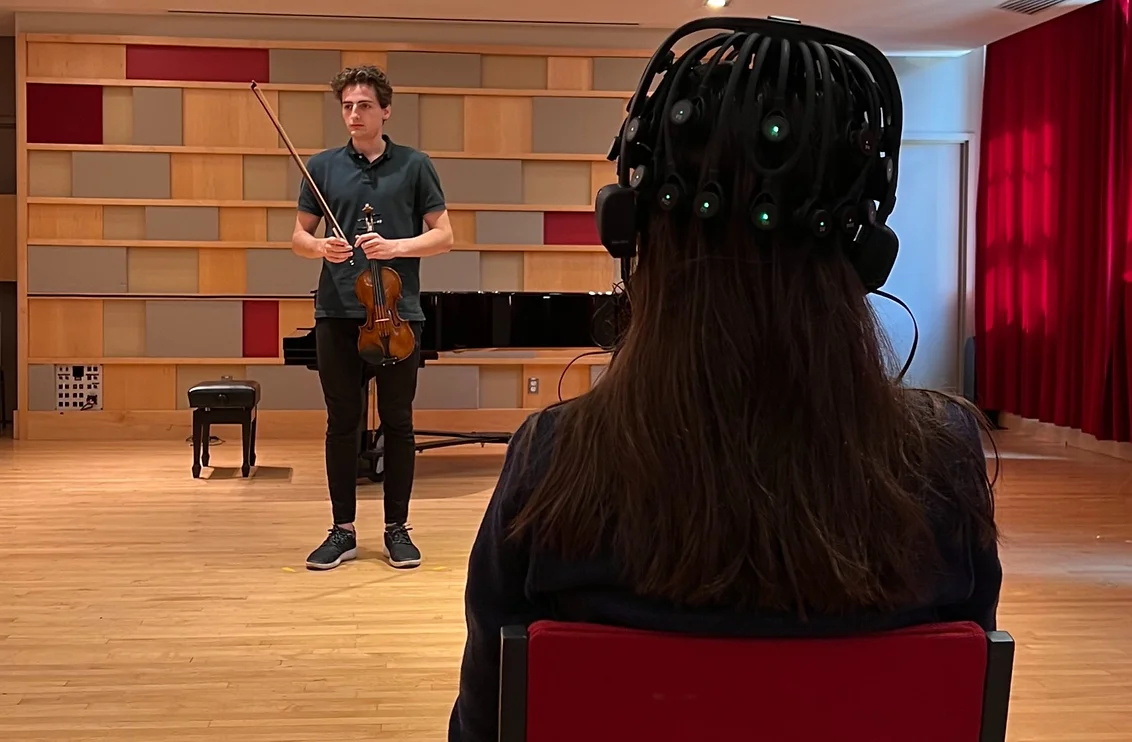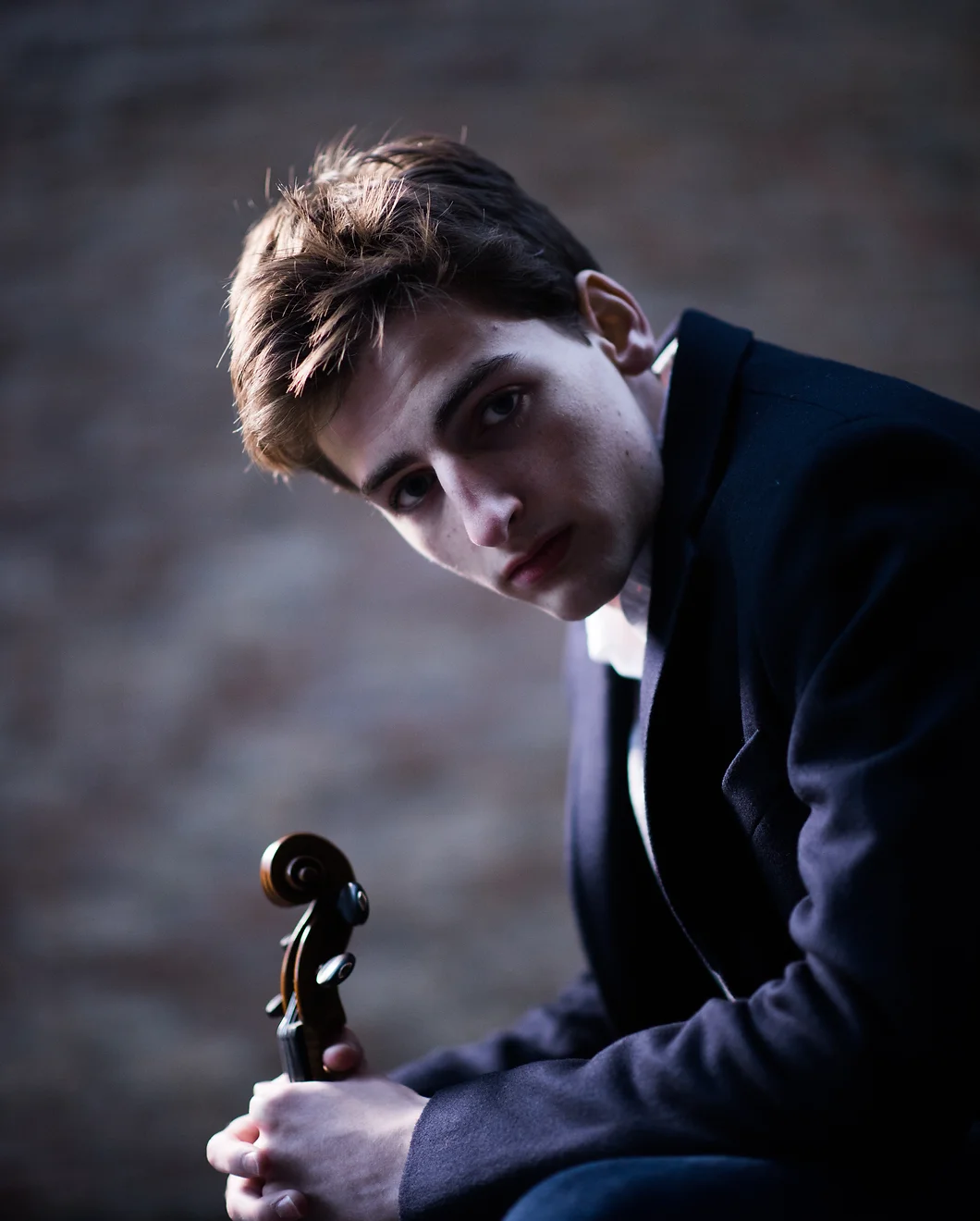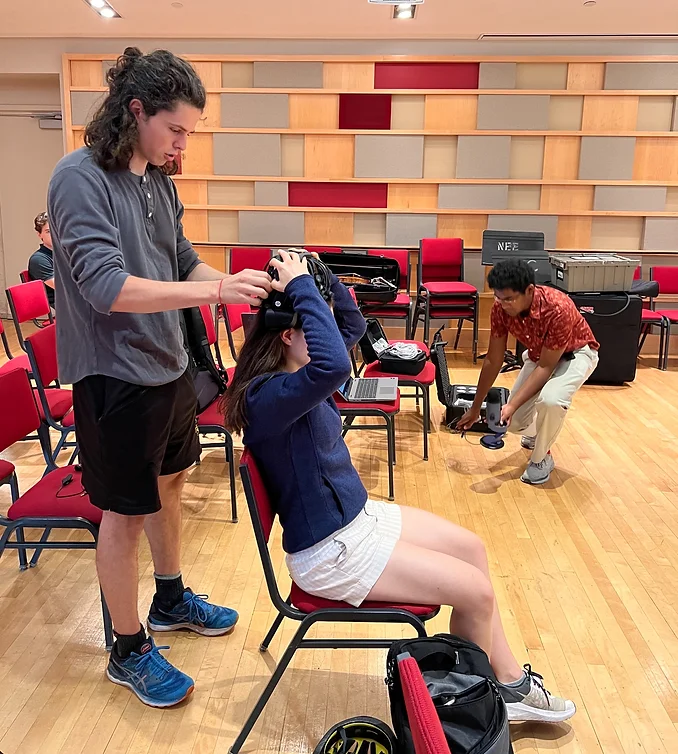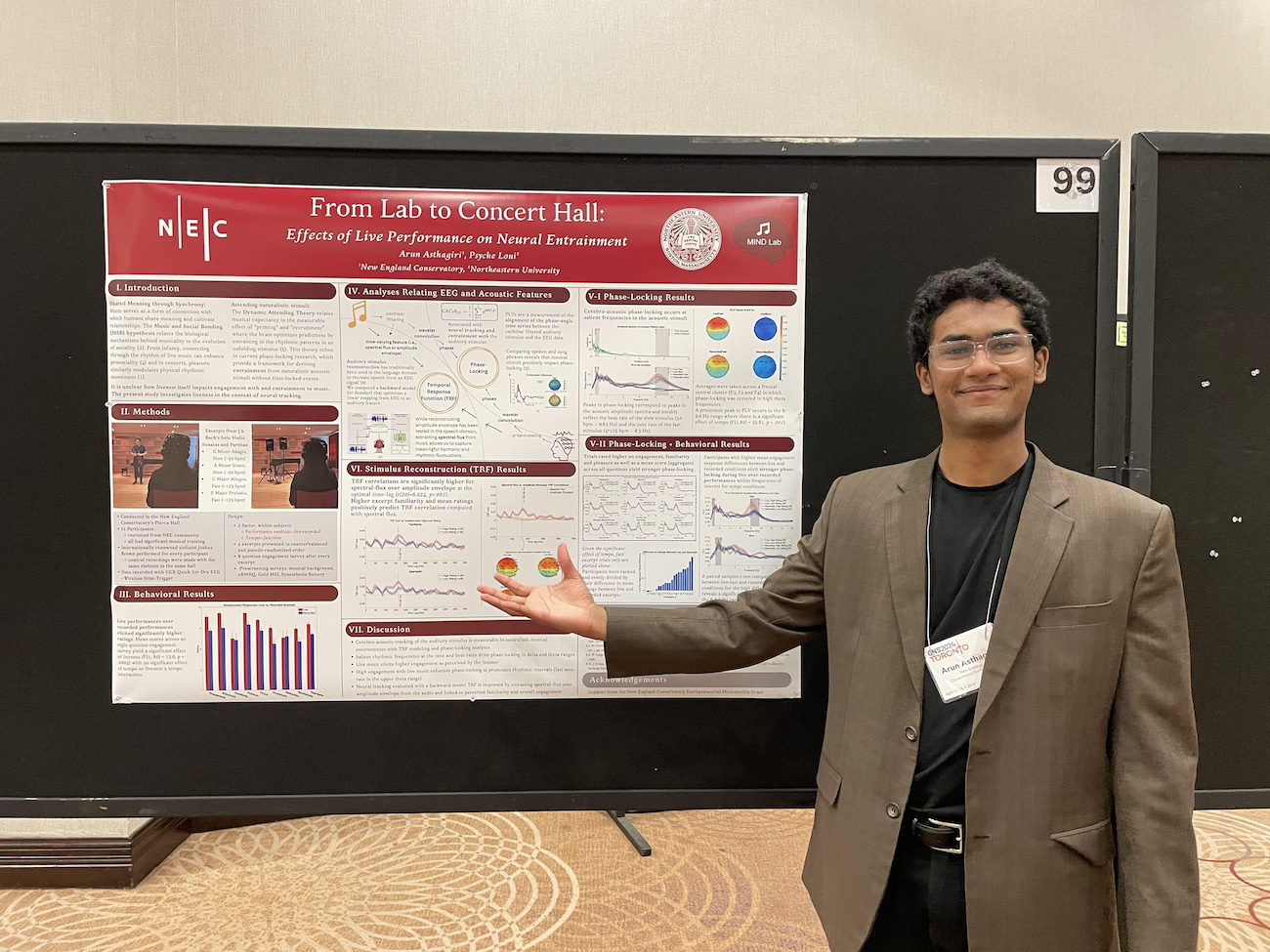How an NEC Violin Student Used Cutting-Edge Neuroscience to Understand the Unspoken Connection Between Performer and Audience
Through an EM Grant and collaboration with Northeastern’s MIND Lab, Arun Asthagiri ’24 analyzed the brainwaves of 21 participants during live and recorded performances at NEC to understand how live music moves and connects us.

It is generally agreed upon that, as an audience member, hearing music performed live — whether a full symphony orchestra, a solo artist, or something in between — is an experience more gratifying than listening to the same piece of music through headphones or speakers. Being in the same room with a performer as they play or sing elevates the listening experience — but why is this the case? What is it about live performance that has the power to move us in such profound ways? Is there a scientific explanation for this phenomenon?

These were the fundamental questions at the heart of “Minds Melody,” a research project led by NEC student and violinist Arun Asthagiri ’24. With funding from a grant through NEC’s Entrepreneurial Musicianship office and close collaboration with Northeastern University’s MIND Lab, Asthagiri explored the relationship between live performers and audience members. “As a violinist, when I'm performing on stage, I feel that there's something different — this special energy. I wanted to see and understand how that takes place,” Asthagiri explained.
Asthagiri is finishing his final semester at NEC after spending over a decade at the conservatory as a student in both the Prep school and the college. Though he is earning his degree in Violin Performance, he has been fascinated by neuroscience and understanding the mechanisms of the brain for many years. “A side of myself that I’ve been deeply pursuing is this neuroscience side of understanding and working with music cognition — how music forms meaning in our brain and how we transform that meaning into connection,” he said. “Everyone talks about music as a universal language, but how does that work? How do we all just understand this thing that doesn't exist with language?”
Asthagiri’s vision for Minds Melody was to explore the relationship between the brain and live performance through experimentation right here on NEC’s campus, utilizing musical mastery within the NEC community to help answer his questions. In Spring 2023, he applied for an NEC Entrepreneurial Musicianship (EM) Grant to fund his experiment. In his pitch to a panel of NEC faculty members and staff, he emphasized how the experiment seeks to help musicians like those in the NEC community better connect with their audience members.
“We are in an age where technology is starting to live in a way that mimics humans. Specifically with music, recording technology is at its peak. But is there something meaningful about the way we have historically and from the origins of humanity communicated through live music? That's this really deep question that I think NEC was very positioned to answer, being a music conservatory focused on live performance.”
The EM Office, led by EM Program Manager Ryan Mewhorter, approved Asthagiri’s grant application, and he was off and running, thanks to a crucial partnership with Northeastern University’s MIND (Music, Imaging, and Neural Dynamics) Lab. The MIND Lab, just down the street from NEC, conducts research that seeks to understand how human beings perceive and produce music, how music can be used to understand the brain, why humans enjoy music, and how music can be used to help people with neurological and psychiatric disorders. The lab is directed by Dr. Psyche Loui, a psychology and neuroscience researcher, Associate Professor of Creativity and Creative Practice at Northeastern, and a violinist herself.
“We do research for music and the brain, including pure research on why we have music, what the brain does when it’s listening and enjoying music, and how making music affects the brain and our mental, neurological, and cognitive health,” said Dr. Loui. “And we also direct more clinical applied studies on things like clinical trials about what music can do for people with Alzheimer’s disease.”
When Asthagiri learned about the kind of research happening at the MIND Lab, he jumped at the opportunity to collaborate with them on Minds Melody. Dr. Loui agreed to mentor the project and oversee its structure, analysis, and planning. The lab’s resources allowed Asthagiri to run EEG brain scans with state-of-the-art brain scanning technology.
"As soon as I heard what his plans were and this general idea of understanding engagement in music using brain activity and brain recordings, I thought it was such a great idea,” said Dr. Loui. “It's a really up-and-coming field of research, trying to use data science and recordings from the body to better understand what it means to engage and to appreciate and be involved.”
With funding, mentorship, and equipment secured, work on Minds Melody began in earnest. The plan was to recruit participants from the NEC community to come to NEC’s Pierce Hall and listen to four excerpts — two performed live and two through a recording. While they listened, participants’ brains would be recorded with an EEG device that scanned their brain waves in real-time.
Asthagiri asked fellow NEC student and rising star violinist Joshua Brown '22, '24 MM to be the performer for the experiment. Last November, Brown won first prize at the China International Music Competition. He debuted with the Cleveland Orchestra at just fifteen years old in 2015 and has since performed with dozens of orchestras in the United States and abroad, continually garnering praise from critics and earning numerous prestigious awards and honors. With his exceptional skill level as a musician and performer, Brown was an ideal choice to create a meaningful listening experience for participants in Minds Melody.

"It was a very exciting process to search for a violinist because we knew this would be something special," said Asthagiri. “Josh was the first person that I reached out to, and I was just so enthusiastic and grateful that he said yes from the very beginning."
Brown and Asthagiri collaborated on what pieces to perform for the experiment, landing on four excerpts from Bach’s Solo Violin Sonatas and Partitas: G Minor Adagio, A Minor Grave, C Major Allegro, and E Major Preludio. “What we went with was the purest form of music we could find for violin, which was solo. And that is something that just very naturally resonates with the instrument,” Asthagiri explained. “Even on the first page of the manuscript, Bach writes something like, 'This is for violin alone.' And so we enter this world alone and bring a connection from that oneness.”
Brown recorded all four Bach excerpts in Pierce Hall and immediately began one-on-one performance sessions with participants, of whom there were 21. Each participant would be hooked up to the EEG device and sit with their eyes closed while listening to the four excerpts Brown performed. Two of the excerpts were at a comparatively slow tempo, and two were comparatively fast. Participants would hear two excerpts performed live directly in front of them and two pre-recorded, with speakers placed at an equal distance away. The order in which each excerpt was performed, as well as which ones were played live versus recorded, varied across participants.
"It was really interesting because on the day I made the recordings, I was happy with how it went, but then I got to see how it really changed throughout the whole process," said Brown. "By the 21st set, I felt like I had so many different ideas about the pieces. I would hear the same recording for the 10th time, and the thing that bothered you a little bit the first time was driving you crazy on the 10th time. But that carried over to the live performance, and it would inspire me to make more changes."
After they listened, participants responded to a questionnaire about their experience. They rated their levels of engagement, enjoyment, familiarity, pleasure, focus, investment, distraction, and spontaneity while listening to the live performance versus the recorded one. The results were sweeping — live performances over recorded performances elicited significantly higher ratings.
"What we found from all these questions was that people felt consistently much more engaged during live performance," said Asthagiri. "They enjoyed it more. They found it more pleasurable. This was a consistent result that we found across all these questions — people are more drawn to live performance and are engaging more deeply with the music. They also find it more spontaneous, and they focus more. In some ways, we expected that response, but it's really cool that we can confirm it first with the behavioral data."

Next came the analysis of the brain data collected by the EEG scanner. “The heart of our analysis was this thing called phase-locking,” Asthagiri explained. "This is used to understand how we get meaning from speech. So if I'm talking to you, you're thinking of all those little sounds I'm making, from words to phrases. Those different time scales that you're parsing my language from, we can actually see them picking up in your brain."
In the Minds Melody experiment, phase-locking measured how musical rhythms affect and align with the rhythms in participants' brains as they sat in Pierce Hall listening to a live performance and a recorded one. The results showed that liveness played a role in enhancing this process.
“What we saw was that there are certain frequency ranges that live performance is really enhancing in the way we're encoding music,” said Asthagiri. “This is really significant because these frequency levels may correspond to the notes and the beat rate. So we have these rhythmic cues from what we're hearing, and we're tracking what is happening better when it's live. So, in other words, we can see in our brain that we're deriving more meaning from what we hear when it's right there."
Simply put, the experiment successfully demonstrated that live performance enhances the way the brain encodes music. To our brains, experiencing live performance is a more meaningful experience than hearing a recording. “This gives concrete evidence that the way we prioritize live classical performance at NEC is a meaningful and tangible human pursuit,” said Asthagiri.
To Brown, a masterful musician and performer without the scientific background of Asthagiri or Dr. Loui, the results did not come as a surprise. "In the experiments, I think you could really feel it in the room," he explained. "We randomized what would start, so sometimes I would play first, and sometimes the recordings would be first. And, to me, you could feel a shift in the room when it went from the recording to when I started playing. So I'm glad to hear the science confirms it, but I think you could feel it, too."
"There is a sentiment that I've seen and heard sometimes that people will say, 'Why would I go to this live concert? There are so many great recordings,'” Brown continued. “And it's true. You can go on YouTube and hear a million different amazing recordings. But I think this study really answers that question of why we should go to live performances, and I think that's so important."
For Dr. Loui, the results of Minds Melody are meaningful because they open the door to a deeper understanding of how to harness the power of music. "On some level, we know that we seek out live music because there's something about your body or mental engagement that's a little bit higher. But I would say this is probably the most careful way in which it's been done so far," she said, describing the level of specificity they were able to attain through the experiment's numerous control factors and how the brain scan analyzed more than just a general level of engagement. "We're looking at how brain activity synchronizes with the sounds of music. We can do this at many different frequencies because we know that some frequencies are more important for rhythm, and other frequencies might be more important for comprehension. Using the brain data, we can start to tease all those things apart. And I think that's what makes the project really rich and interesting; it's not just saying that live music is better than recorded, but it's answering how it's better. In what way is the brain specifically synchronizing, and how can we then use that to design experiences that might be more consistently engaging for more people."

Asthagiri is excited to share the findings of Minds Melody with the world. This month, he presented the results at the Cognitive Neuroscience Society 2024 Annual Meeting in Toronto. After graduating from NEC this May, he will begin working toward his Ph.D. with Northeastern’s MIND Lab, continuing his research on the effect of music on the brain under the guidance of Dr. Loui. He is thrilled that a project like Minds Melody was able to bring these two world-renowned institutions together in a way they had not collaborated before.
"Honestly, what excites me the most about this is this collaboration between academia and NEC. I feel like that is something I can really contribute as a musician in this field. I can bring musicians who really care about the music side into understanding how it's actually making an impact in the world,” he explained. “So that's where I see this collaboration growing between NEC and the MIND Lab — working with musicians in live performance, whether on stage or in the audience, to enhance how we understand this type of music-making, which will eventually feed back into how we make music itself. If we know the types of ways that our connection achieves its greatest impact, then that's how we should explore as artists."
This gives concrete evidence that the way we prioritize live classical performance at NEC is a meaningful and tangible human pursuit.
